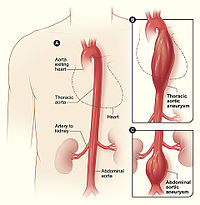
Photo from wikipedia
OBJECTIVES This study aimed to analyse risk factors for postoperative stroke, evaluate the underlying mechanisms and report on outcomes of patients suffering a postoperative stroke after total aortic arch replacement… Click to show full abstract
OBJECTIVES This study aimed to analyse risk factors for postoperative stroke, evaluate the underlying mechanisms and report on outcomes of patients suffering a postoperative stroke after total aortic arch replacement using the frozen elephant trunk technique. METHODS Two-hundred and fifty patients underwent total aortic arch replacement via the frozen elephant trunk technique between March 2013 and November 2020 for acute and chronic aortic pathologies. Postoperative strokes were evaluated interdisciplinarily by a cardiac surgeon, neurologist and radiologist, and subclassified to each's cerebral territory. We conducted a logistic regression analysis to identify any predictors for postoperative stroke. RESULTS Overall in-hospital was mortality 10% (25 patients, 11 with a stroke). A symptomatic postoperative stroke occurred in 42 (16.8%) of our cohort. Eight thereof were non-disabling (3.3%), whereas 34 (13.6%) were disabling strokes. The most frequently affected region was the arteria cerebri media. Embolism was the primary underlying mechanism (n = 31; 73.8%). Mortality in patients with postoperative stroke was 26.2%. Logistic regression analysis revealed age over 75 (odds ratio = 3.25; 95% confidence interval 1.20-8.82; P = 0.021), a bovine arch (odds ratio = 4.96; 95% confidence interval 1.28-19.28; P = 0.021) and an acute preoperative neurological deficit (odds ratio = 19.82; 95% confidence interval 1.09-360.84; P = 0.044) as predictors for postoperative stroke. CONCLUSIONS Stroke after total aortic arch replacement using the frozen elephant trunk technique remains problematic, and most lesions are of embolic origin. Refined organ protection strategies, and sophisticated monitoring are mandatory to reduce the incidence of postoperative stroke, particularly in older patients presenting an acute preoperative neurological deficit or bovine arch.
Journal Title: Interactive cardiovascular and thoracic surgery
Year Published: 2022
Link to full text (if available)
Share on Social Media: Sign Up to like & get
recommendations!